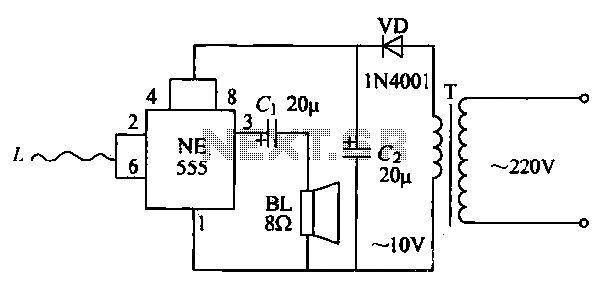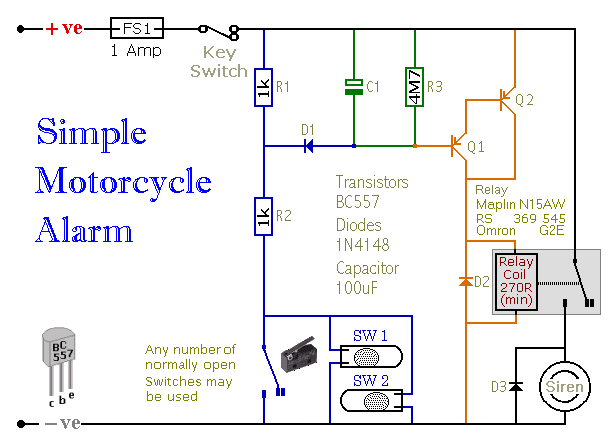
Single-Ic Alarm

With a single integrated circuit (IC), it is possible to construct a straightforward and dependable auto burglar alarm or a similar alarm system. Refer to (a) for the timing information related to the alarm circuit in (b). When leaving the vehicle, the user should activate the arming switch and close the door to set the device. The subsequent opening of any entrance will trigger both timers. After the entry delay timer expires, the alarm will sound for a duration determined by the second timer. The resistance value for R should be less than 1 kOhm. Utilizing an incandescent lamp instead of a resistor introduces an additional function—an open-entrance indicator. Maintaining a low resistance helps prevent false triggering in case water accumulates under the hood. If the door switch connects the courtesy light to 12 V instead of ground, a single transistor can be employed as an inverter at the input. While the simplicity of this circuit may present some limitations, it allows for the addition of features such as no-entry delays for the hood and trunk, as well as retriggering if doors remain open.
The described auto burglar alarm circuit utilizes a single integrated circuit to streamline the design while maintaining functionality. The primary operation involves an arming mechanism activated by a switch when the user exits the vehicle, which sets the system in standby mode. The circuit employs two timers: the first timer serves as an entry delay, allowing the user a brief period to re-enter the vehicle without triggering the alarm. The second timer controls the duration of the alarm sound once the entry delay has elapsed.
The resistance value for the timing components, specifically R, is critical for ensuring that the circuit operates effectively. A resistor value of less than 1 kOhm is recommended to optimize the response time of the timers. If an incandescent lamp is incorporated in place of a resistor, the circuit gains the added benefit of providing a visual indication of an open entrance, enhancing user awareness.
To further enhance the reliability of the system, the design includes considerations for environmental factors, such as water accumulation. By selecting a low resistance value, the circuit minimizes the risk of false alarms due to moisture. Additionally, in scenarios where the door switch is wired to 12 V instead of ground, a transistor inverter is suggested to ensure proper signal processing.
The simplicity of this alarm circuit does not preclude the possibility of expanding its capabilities. Users can incorporate features such as no-entry delays for other access points, including the hood and trunk, and implement retriggering mechanisms for situations where doors are left open. This flexibility allows for customization based on user preferences and security needs, making it a versatile solution for vehicle protection. With a single IC, you can build a simple, reliable auto burglar alarm or a similar alarm. See (a) for the timing informatio n for the alarm circuit in (b). When you leave your vehicle, flip the arming switch and close the door behind you to arm the device. Subsequent opening of an entrance triggers both timers. After the expiration of the entry delay timer, the alarm sounds for a time that is determined by the second timer. The value of R should be less than 1 KOhmhm. If you use an incandescent lamp instead of a resistor, you get an extra function—an open-entrance indicator.
By keeping the resistance low, you avoid false tripping should water collect under the hood. If your door switch connects the courtesy light to 12 V rather than to ground, use a single transistor as an inverter at the input. Although this circuit"s simplicity has its drawbacks, you can add more features, such as no-entry delays for the hood and trunk, and retripping when doors remain open.
The described auto burglar alarm circuit utilizes a single integrated circuit to streamline the design while maintaining functionality. The primary operation involves an arming mechanism activated by a switch when the user exits the vehicle, which sets the system in standby mode. The circuit employs two timers: the first timer serves as an entry delay, allowing the user a brief period to re-enter the vehicle without triggering the alarm. The second timer controls the duration of the alarm sound once the entry delay has elapsed.
The resistance value for the timing components, specifically R, is critical for ensuring that the circuit operates effectively. A resistor value of less than 1 kOhm is recommended to optimize the response time of the timers. If an incandescent lamp is incorporated in place of a resistor, the circuit gains the added benefit of providing a visual indication of an open entrance, enhancing user awareness.
To further enhance the reliability of the system, the design includes considerations for environmental factors, such as water accumulation. By selecting a low resistance value, the circuit minimizes the risk of false alarms due to moisture. Additionally, in scenarios where the door switch is wired to 12 V instead of ground, a transistor inverter is suggested to ensure proper signal processing.
The simplicity of this alarm circuit does not preclude the possibility of expanding its capabilities. Users can incorporate features such as no-entry delays for other access points, including the hood and trunk, and implement retriggering mechanisms for situations where doors are left open. This flexibility allows for customization based on user preferences and security needs, making it a versatile solution for vehicle protection. With a single IC, you can build a simple, reliable auto burglar alarm or a similar alarm. See (a) for the timing informatio n for the alarm circuit in (b). When you leave your vehicle, flip the arming switch and close the door behind you to arm the device. Subsequent opening of an entrance triggers both timers. After the expiration of the entry delay timer, the alarm sounds for a time that is determined by the second timer. The value of R should be less than 1 KOhmhm. If you use an incandescent lamp instead of a resistor, you get an extra function—an open-entrance indicator.
By keeping the resistance low, you avoid false tripping should water collect under the hood. If your door switch connects the courtesy light to 12 V rather than to ground, use a single transistor as an inverter at the input. Although this circuit"s simplicity has its drawbacks, you can add more features, such as no-entry delays for the hood and trunk, and retripping when doors remain open.





